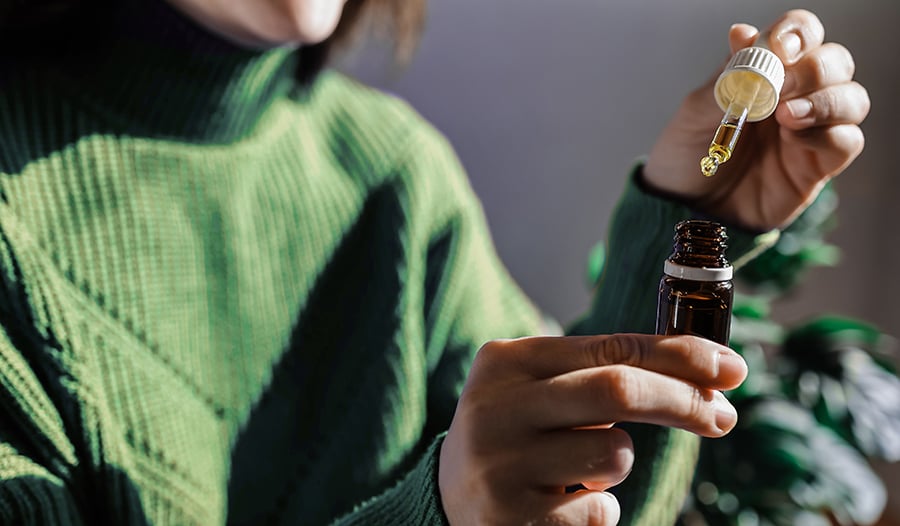Niacinamide: Vitamin B3 Deficiency, Skin Benefits, Food Sources, and More
DISCLAIMER:This blog does not intend to provide diagnosis...
- In this article:
- What Is Niacinamide?
- What Does Vitamin B (Niacin) Do?
- What Is NAD?
- Niacinamide for Vitamin B3 Deficiency
- Symptoms of Vitamin B3 Deficiency
- Niacinamide Skin Benefits
- 1. Protect Against UV Rays
- 2. Reduce Actinic Keratosis
- 3. Improve Overall Skin Appearance
- Food Sources of Niacinamide
- Niacinamide vs. Niacin Supplements
- Takeaway

Niacinamide has been growing in popularity for those who want to optimize their health and wellness, both inside and out. Studies suggest that this vitamin that belongs to the group of B vitamins has some pretty versatile and beneficial effects on health. What exactly is niacinamide, and what is it used for?
What Is Niacinamide?
Niacinamide, also known as nicotinamide, is a form of the water-soluble vitamin B3, or niacin.
What Does Vitamin B (Niacin) Do?
Niacin is a vitamin used by the body for optimal functioning of metabolism, digestion, skin health, and the nervous system. Niacin, once ingested, is metabolized into nicotinamide adenine dinucleotide (NAD).
What Is NAD?
NAD is a coenzyme. A coenzyme is a vitamin, mineral, or nonprotein nutrient needed for the proper functioning of an enzyme.
NAD is required for over 400 different enzymes to function properly. Some of the functions of NAD include turning food into energy usable by the body, promoting metabolism, repairing deoxyribonucleic acid (DNA), and even promoting healthy immune function.
NAD may also play a supportive role in how cells experience aging.
While niacinamide is often used as a vitamin B3 supplement to address or prevent vitamin B3 deficiency, it can also be used as a topical in cosmetic preparations to promote skin health.
Research suggests that niacinamide has various health benefits beyond addressing vitamin B3 deficiency, ranging from supporting healthy cholesterol levels and diabetes prevention to glowing skin.
Niacinamide for Vitamin B3 Deficiency
One of the main benefits and uses of niacinamide is to prevent or address vitamin B3 deficiency.
Vitamin B3 deficiency, also called pellagra, occurs when an individual doesn’t get enough niacin in their diet or has problems absorbing the vitamin. Pellagra is often seen in individuals who suffer from malnourishment or chronic alcoholism.
Vitamin B3 deficiency can also occur if there isn’t enough tryptophan intake in the diet. Tryptophan is an amino acid found in a variety of foods that are used as a precursor to niacin production in the body.
Symptoms of Vitamin B3 Deficiency
Signs and symptoms of vitamin B3 deficiency or pellagra include mental confusion, gastrointestinal symptoms like diarrhea and pain in the abdomen, poor appetite, and scaly inflamed skin and mucus membranes. If left untreated, pellagra can be fatal. Niacinamide is often used to treat pellagra. The World Health Organization (WHO) recommends 300 mg of niacinamide a day for 3-4 weeks as treatment for pellagra.
Niacinamide Skin Benefits
One of the most extensively studied uses for niacinamide is for skin health, both with topical and oral use. Research shows that niacinamide may help to improve skin texture, appearance, and overall quality.
1. Protect Against UV Rays
One of the ways that niacinamide may help to improve skin quality is by helping to protect the skin from the effects of ultraviolet (UV) radiation. UV radiation is a type of energy emitted from the sun and certain man-made sources like tanning beds. UV radiation has been classified as a “complete carcinogen” because it not only causes the mutation of DNA in the skin but it also causes damage to skin cells which can lead to skin cancer.
Studies show that both oral and topical niacinamide supplementation may help to protect against UV skin damage. One study even found that topical niacinamide use, as well as supplementation, helped reduce UV-induced immune system suppression while reducing the risk of skin cancer.
2. Reduce Actinic Keratosis
Studies suggest that niacinamide may also help to reduce actinic keratosis. Actinic keratosis (keratoses for more than one lesion) is a skin disorder caused by excessive UV radiation exposure. Actinic keratosis is marked by dry, scaly, rough patches of skin that may be colored pink or brown. These skin lesions may also be itchy or cause burning pain. They may also bleed. Actinic keratosis has the potential to develop into squamous cell carcinoma, a malignant skin cancer.
One double-blind, randomized, placebo-controlled study followed 72 individuals who were diagnosed with at least 4 actinic keratosis lesions. Participants were either placed in a group that received niacinamide or a placebo group. At a 4-month follow-up, the study found that those who took a niacinamide supplement had a significantly lower development of new actinic keratosis lesions compared to those in the placebo group.
3. Improve Overall Skin Appearance
Research also suggests that niacinamide may also help to improve the appearance of the skin overall. One involving 50 females with fine lines, dark patches of pigmentation on the face, uneven skin texture, and wrinkles followed participants who used a topical preparation of a product containing niacinamide for 12 weeks. The participants only used the topical niacinamide preparation on one half of the face while applying a placebo cream to the other half.
After 12 weeks, the study found that half of the face that received the niacinamide preparation had a significant reduction of fine lines and dark skin patches. There was also a significant improvement in the elasticity of the skin that received the niacinamide preparation compared to placebo.
Food Sources of Niacinamide
Since niacinamide is a naturally occurring substance, it can be found in many different foods. One of the best food sources of niacinamide is found in the amino acid tryptophan.
Tryptophan can be found in foods like chicken, tuna, turkey, peanuts, oats, bananas, and chocolate. Once ingested, tryptophan is naturally converted into niacinamide in the liver. This process requires vitamin B6, iron, and vitamin B2 or riboflavin for optimal conversion.
While niacinamide can be produced in the liver from tryptophan, many foods naturally contain the vitamin itself. Niacin and niacinamide can be found in a range of food groups including meats, nuts and seeds, dairy, grains, and fruits and vegetables. A list of foods that are high in niacin includes the following. The amounts of niacin listed are per serving.
Meats
- Beef liver 14.9 milligrams (mg)
- Pork 6.3 mg
- Tuna 8.6 mg
- Salmon 8.6 mg
- Turkey breast 10 mg
- Chicken breast 10.3 mg
Nuts and seeds
- Sunflower seeds 2 mg
- Pumpkin seeds 1.3 mg
- Cashews 0.4 mg
Dairy
- 1% Milk 0.2 mg
- Plain low-fat yogurt 0.3 mg
Grains
- Whole wheat bread 1.4 mg
- Bulgar 0.9 mg
- Brown rice 5.2 mg
Fruits and vegetables
- Banana 0.8 mg
- 1/2 cup of raisins 0.6 mg
- Broccoli 0.4 mg
- Tomatoes 0.5 mg
Since niacin is found in various foods, eating a varied diet helps promote optimal vitamin B3 intake.
Niacinamide vs. Niacin Supplements
When it comes to oral supplementation, niacinamide is often preferred over niacin. This is because higher doses of niacin can redness, itchiness, and a sensation of warmth in the skin. This uncomfortable condition is known as flushing and can last up to an hour.
Since niacinamide doesn’t cause flushing, it can be taken in the same way as niacin without the potential for discomfort. While niacinamide may address pellagra, it also has other health benefits that range from diabetes support and lowering cholesterol levels to improving skin health.
Takeaway
Niacinamide is a naturally occurring and versatile form of vitamin B3. This exceptionally versatile vitamin is known for its ability to promote health and wellness in a variety of body systems, ranging from metabolic health to skin health.
Whether the goal is glowing skin or healthy cholesterol levels, adding niacinamide into a comprehensive wellness routine may help to promote optimal health for years to come.
References:
- Boo YC. Mechanistic Basis and Clinical Evidence for the Applications of Nicotinamide (Niacinamide) to Control Skin Aging and Pigmentation. Antioxidants (Basel). 2021;10(8):1315. Published 2021 Aug 21. doi:10.3390/antiox10081315
- Çatak J. Determination of niacin profiles in some animal and plant based foods by high performance liquid chromatography: association with healthy nutrition. J Anim Sci Technol. 2019;61(3):138-146. doi:10.5187/jast.2019.61.3.138
- Cheng SC, Young DO, Huang Y, Delmez JA, Coyne DW. A randomized, double-blind, placebo-controlled trial of niacinamide for reduction of phosphorus in hemodialysis patients. Clin J Am Soc Nephrol. 2008;3(4):1131-1138. doi:10.2215/CJN.04211007
- Chi Y, Sauve AA. Nicotinamide riboside, a trace nutrient in foods, is a vitamin B3 with effects on energy metabolism and neuroprotection. Curr Opin Clin Nutr Metab Care. 2013;16(6):657-661. doi:10.1097/MCO.0b013e32836510c0
- Covarrubias AJ, Perrone R, Grozio A, Verdin E. NAD+ metabolism and its roles in cellular processes during aging. Nat Rev Mol Cell Biol. 2021;22(2):119-141. doi:10.1038/s41580-020-00313-x
- D'Orazio J, Jarrett S, Amaro-Ortiz A, Scott T. UV radiation and the skin. Int J Mol Sci. 2013;14(6):12222-12248. Published 2013 Jun 7. doi:10.3390/ijms140612222
- Gehring W. Nicotinic acid/niacinamide and the skin. J Cosmet Dermatol. 2004;3(2):88-93. doi:10.1111/j.1473-2130.2004.00115.x
- Madaan P, Sikka P, Malik DS. Cosmeceutical Aptitudes of Niacinamide: A Review. Recent Adv Antiinfect Drug Discov. 2021;16(3):196-208. doi:10.2174/2772434416666211129105629
- Mainville L, Smilga AS, Fortin PR. Effect of Nicotinamide in Skin Cancer and Actinic Keratoses Chemoprophylaxis, and Adverse Effects Related to Nicotinamide: A Systematic Review and Meta-Analysis. J Cutan Med Surg. 2022;26(3):297-308. doi:10.1177/12034754221078201
- Méndez-Lara KA, Letelier N, Farré N, Diarte-Añazco EMG, Nieto-Nicolau N, Rodríguez-Millán E, Santos D, Pallarès V, Escolà-Gil JC, Vázquez del Olmo T, Lerma E, Camacho M, Casaroli-Marano RP, Valledor AF, Blanco-Vaca F, Julve J. Nicotinamide Prevents Apolipoprotein B-Containing Lipoprotein Oxidation, Inflammation and Atherosclerosis in Apolipoprotein E-Deficient Mice. Antioxidants. 2020; 9(11):1162. https://doi.org/10.3390/antiox9111162
- Prinzo ZW. Pellagra and its prevention and control in major emergencies. World Health Organization. 2000.
- Rolfe HM. A review of nicotinamide: treatment of skin diseases and potential side effects. J Cosmet Dermatol. 2014;13(4):324-328. doi:10.1111/jocd.12119
- Snaidr VA, Damian DL, Halliday GM. Nicotinamide for photoprotection and skin cancer chemoprevention: A review of efficacy and safety. Exp Dermatol. 2019;28 Suppl 1:15-22. doi:10.1111/exd.13819 (MOA cancer protection)
- Wohlrab J, Kreft D. Niacinamide - mechanisms of action and its topical use in dermatology. Skin Pharmacol Physiol. 2014;27(6):311-315. doi:10.1159/000359974
- Yilmaz Z, Piracha F, Anderson L, Mazzola N. Supplements for Diabetes Mellitus: A Review of the Literature. J Pharm Pract. 2017;30(6):631-638. doi:10.1177/0897190016663070
- Zhong, O., Wang, J., Tan, Y. et al. Effects of NAD+ precursor supplementation on glucose and lipid metabolism in humans: a meta-analysis. Nutr Metab (Lond) 19, 20 (2022). https://doi.org/10.1186/s12986-022-00653-9

 By Dr. Candace Mathers, N.D.
By Dr. Candace Mathers, N.D.


